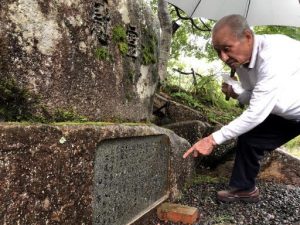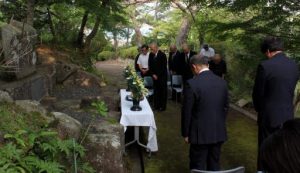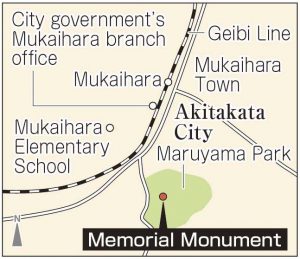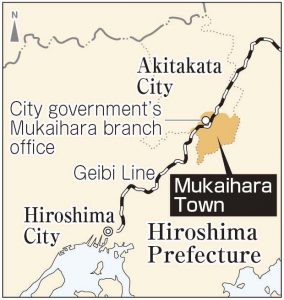Seventy-five years after the atomic bombing—Survivors’ groups at crossroads, Part 1: Few people to take reins in Hiroshima
Jul. 21, 2020
by Junji Akechi, Staff Writer
The inscription on the memorial monument reads “Consoling the spirits of the dead,” as the moss on the monument grows greener with increasingly heavy rain. The monument is located in Maruyama Park in the Mukaihara district of the city of Akitakata. “We usually clean the monument for the ceremony,” Yuko Tamagawa, 87, president of a survivors’ association in Mukaihara, remarked forlornly on July 6.
On August 6 this year, the 75th anniversary of the atomic bombings, the association is set to disband. When the group made the decision in 2017, most members were of the mindset that it was unavoidable. The association’s records indicate its membership numbered 540 in 1986. But that number has decreased year by year to the point now at which there are only 135 members. According to Mr. Tamagawa, only a few are actually involved in the group’s operations.
One of the association’s main activities has been managing an annual memorial ceremony held in front of the monument erected for those who died in Mukaihara. This year’s ceremony was to be the association’s last, but it had to cancel the ceremony due to the COVID-19 pandemic. The threat of the new infectious disease has cast a dark shadow over the group’s closing chapter. Mr. Tamagawa, however, persuaded himself. “We can mourn the dead in our hearts.”
What worries him is what will happen to the monument, which preserves the memory of more than 100 victims. Who will take care of the monument and pass on memories of the deceased? He believes it is his final duty as president to find someone to care for the monument.
The memorial monument, which stands in Maruyama Park in the Mukaihara district of Akitakata City, was erected by members of a local A-bomb survivors’ group in 1981. Originally, the monument stood where A-bomb victims’ bodies were cremated, but it was moved to its present location in 1995. On the monument are inscribed the words, “More than 100 victims died in agony amid an absence of medical supplies.”
The survivors’ association was formed in 1965. Its members included those who were exposed to residual radiation after entering Hiroshima to search for family members and involved in relief operations for the injured brought to Mukaihara National School (now Mukaihara Elementary School). Group members engaged in numerous activities based on mutual support and cultivation of friendships, as well as poured energy into the consoling of souls of those who died in Mukaihara.
Role inscribed in heart
Mr. Tamagawa, 87, became the association’s president in 2011. He said that older residents told him they cremated so many bodies they had ran out of wood. He firmly believed it was his role to maintain the monument and continue consoling souls of the victims. His own experience in the atomic bombing strengthened his resolve.
Mr. Tamagawa was a first-year student at Hiroshima Second Middle School (now Kannon High School) and was on his way from his home in Saijo (now Higashihiroshima City) to a job site at which he would help tear down houses to create fire lanes. He experienced the bombing in front of the Hiroshima Station (now Minami Ward) about two kilometers from the hypocenter. Although he suffered burns on his face and hands, he survived after spending a day to reach his home.
All his classmates who were working in the Nakajima-shinmachi district (now Naka Ward) were killed. The names of his 323 classmates, including those who died later, were engraved in the school monument erected in Hiroshima Peace Memorial Park.
Mr. Tamagawa cannot forget the mother of one of his classmates who lived in his neighborhood. As the son was missing, his mother visited Mr. Tamagawa at home again and again, desperately asking after her son. Mr. Tamagawa heard that she went to Hiroshima Station numerous times to find clues to her son’s whereabouts. “Victims who died in Mukaihara had family members. They must have searched desperately,” he thought, his heart breaking with the thoughts about their chagrin.
Because its members are decreasing in number and aging, the association will disband on this year’s anniversary of the atomic bombing. The group has long held a memorial service in front of the monument in Maruyama Park, but this year’s ceremony has been canceled due to the novel coronavirus pandemic. Last year’s ceremony, which ultimately was the association’s final one, was held on August 3 and attended by 13 people. All shared the idea that, wars must never be fought, and inhumane nuclear weapons are unforgivable.
Understanding difficulties
“At one time I thought of having second-generation survivors take over our association’s activities,” said Mr. Tamagawa. But he could not find people who were willing to take on the responsibility. Mr. Tamagawa himself has led a busy life, leaving Hiroshima to work for a trading company and other organizations. He joined the association in 1992 after retiring and returning to his hometown. He understands it is hard for people to get involved in such activities while trying to manage a career.
In areas around Mukaihara, situations are similarly hard. When six towns merged to form the city of Akitakata in 2004, there was a similar group in each of the towns. The group based in the former town of Midori was dissolved in 2005. Between 2015 and 2016, the groups in Koda, Yachiyo, Takamiya and Yoshida disbanded because of their aging membership. The Takamiya group’s activities were taken over by a new group with some of its members. In this way, even in Hiroshima Prefecture continuation of the A-bomb survivors’ movement has grown more difficult.
Members of his association worked hard, believes Mr. Tamagawa, to at least communicate to younger generations the fact that some people had to die without being identified. “Hoping for peace, I have done what I can.” Now he hopes that the monument is maintained no matter what, even after the association disbands.
The 75th anniversary of the U.S. atomic bombings is approaching. A-bomb survivors’ groups in different corners of the country have served as places for people who suffered hardship to help each other and demand relief measures for survivors and the elimination of nuclear weapons. According to the results of a survey conducted by the Chugoku Shimbun on A-bomb survivors’ groups across the nation, however, the aging of survivors is making it hard for such groups to continue to exist. In this series, we look at the groups’ histories, which coincide with the lives of survivors, and try to discern their future.
(Originally published on July 21, 2020)
The inscription on the memorial monument reads “Consoling the spirits of the dead,” as the moss on the monument grows greener with increasingly heavy rain. The monument is located in Maruyama Park in the Mukaihara district of the city of Akitakata. “We usually clean the monument for the ceremony,” Yuko Tamagawa, 87, president of a survivors’ association in Mukaihara, remarked forlornly on July 6.
On August 6 this year, the 75th anniversary of the atomic bombings, the association is set to disband. When the group made the decision in 2017, most members were of the mindset that it was unavoidable. The association’s records indicate its membership numbered 540 in 1986. But that number has decreased year by year to the point now at which there are only 135 members. According to Mr. Tamagawa, only a few are actually involved in the group’s operations.
One of the association’s main activities has been managing an annual memorial ceremony held in front of the monument erected for those who died in Mukaihara. This year’s ceremony was to be the association’s last, but it had to cancel the ceremony due to the COVID-19 pandemic. The threat of the new infectious disease has cast a dark shadow over the group’s closing chapter. Mr. Tamagawa, however, persuaded himself. “We can mourn the dead in our hearts.”
What worries him is what will happen to the monument, which preserves the memory of more than 100 victims. Who will take care of the monument and pass on memories of the deceased? He believes it is his final duty as president to find someone to care for the monument.
Groups in Hiroshima disband, amid hopes to maintain the monument
The memorial monument, which stands in Maruyama Park in the Mukaihara district of Akitakata City, was erected by members of a local A-bomb survivors’ group in 1981. Originally, the monument stood where A-bomb victims’ bodies were cremated, but it was moved to its present location in 1995. On the monument are inscribed the words, “More than 100 victims died in agony amid an absence of medical supplies.”
The survivors’ association was formed in 1965. Its members included those who were exposed to residual radiation after entering Hiroshima to search for family members and involved in relief operations for the injured brought to Mukaihara National School (now Mukaihara Elementary School). Group members engaged in numerous activities based on mutual support and cultivation of friendships, as well as poured energy into the consoling of souls of those who died in Mukaihara.
Role inscribed in heart
Mr. Tamagawa, 87, became the association’s president in 2011. He said that older residents told him they cremated so many bodies they had ran out of wood. He firmly believed it was his role to maintain the monument and continue consoling souls of the victims. His own experience in the atomic bombing strengthened his resolve.
Mr. Tamagawa was a first-year student at Hiroshima Second Middle School (now Kannon High School) and was on his way from his home in Saijo (now Higashihiroshima City) to a job site at which he would help tear down houses to create fire lanes. He experienced the bombing in front of the Hiroshima Station (now Minami Ward) about two kilometers from the hypocenter. Although he suffered burns on his face and hands, he survived after spending a day to reach his home.
All his classmates who were working in the Nakajima-shinmachi district (now Naka Ward) were killed. The names of his 323 classmates, including those who died later, were engraved in the school monument erected in Hiroshima Peace Memorial Park.
Mr. Tamagawa cannot forget the mother of one of his classmates who lived in his neighborhood. As the son was missing, his mother visited Mr. Tamagawa at home again and again, desperately asking after her son. Mr. Tamagawa heard that she went to Hiroshima Station numerous times to find clues to her son’s whereabouts. “Victims who died in Mukaihara had family members. They must have searched desperately,” he thought, his heart breaking with the thoughts about their chagrin.
Because its members are decreasing in number and aging, the association will disband on this year’s anniversary of the atomic bombing. The group has long held a memorial service in front of the monument in Maruyama Park, but this year’s ceremony has been canceled due to the novel coronavirus pandemic. Last year’s ceremony, which ultimately was the association’s final one, was held on August 3 and attended by 13 people. All shared the idea that, wars must never be fought, and inhumane nuclear weapons are unforgivable.
Understanding difficulties
“At one time I thought of having second-generation survivors take over our association’s activities,” said Mr. Tamagawa. But he could not find people who were willing to take on the responsibility. Mr. Tamagawa himself has led a busy life, leaving Hiroshima to work for a trading company and other organizations. He joined the association in 1992 after retiring and returning to his hometown. He understands it is hard for people to get involved in such activities while trying to manage a career.
In areas around Mukaihara, situations are similarly hard. When six towns merged to form the city of Akitakata in 2004, there was a similar group in each of the towns. The group based in the former town of Midori was dissolved in 2005. Between 2015 and 2016, the groups in Koda, Yachiyo, Takamiya and Yoshida disbanded because of their aging membership. The Takamiya group’s activities were taken over by a new group with some of its members. In this way, even in Hiroshima Prefecture continuation of the A-bomb survivors’ movement has grown more difficult.
Members of his association worked hard, believes Mr. Tamagawa, to at least communicate to younger generations the fact that some people had to die without being identified. “Hoping for peace, I have done what I can.” Now he hopes that the monument is maintained no matter what, even after the association disbands.
The 75th anniversary of the U.S. atomic bombings is approaching. A-bomb survivors’ groups in different corners of the country have served as places for people who suffered hardship to help each other and demand relief measures for survivors and the elimination of nuclear weapons. According to the results of a survey conducted by the Chugoku Shimbun on A-bomb survivors’ groups across the nation, however, the aging of survivors is making it hard for such groups to continue to exist. In this series, we look at the groups’ histories, which coincide with the lives of survivors, and try to discern their future.
(Originally published on July 21, 2020)











